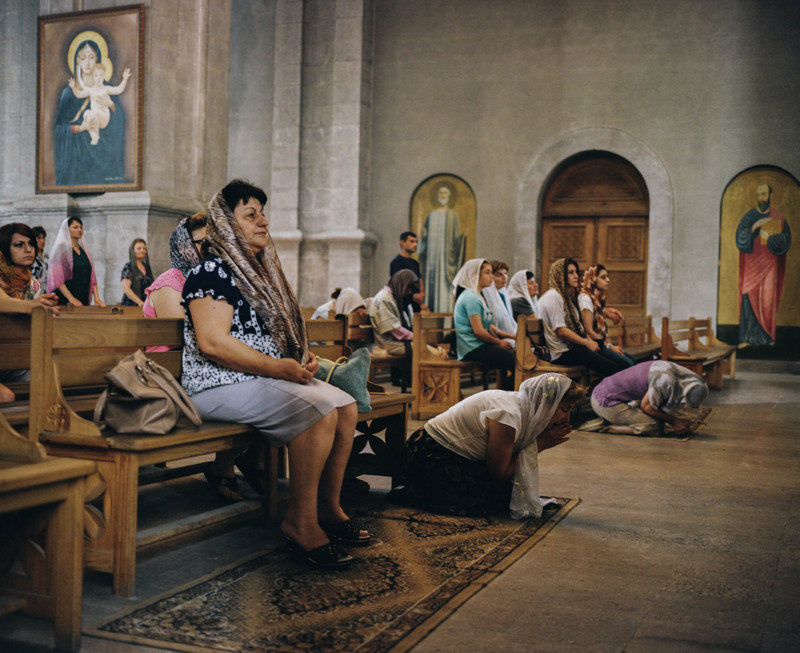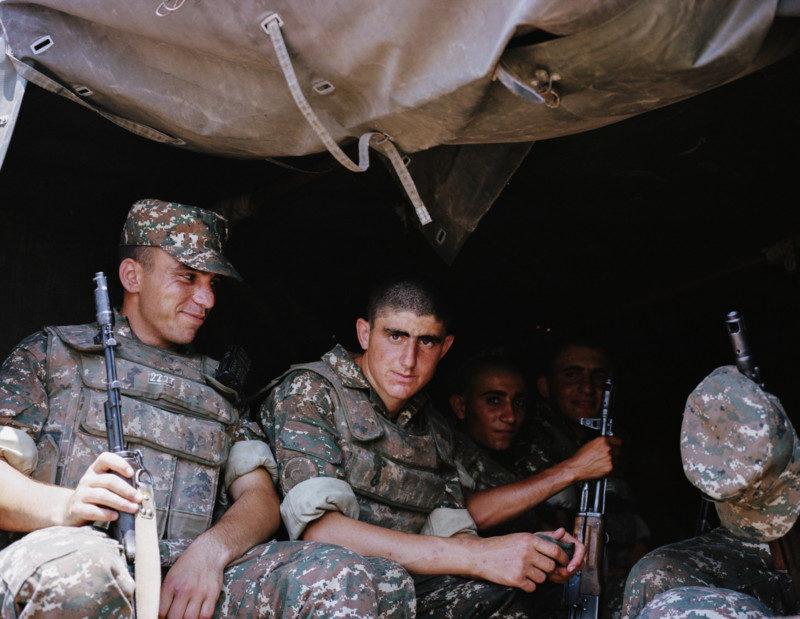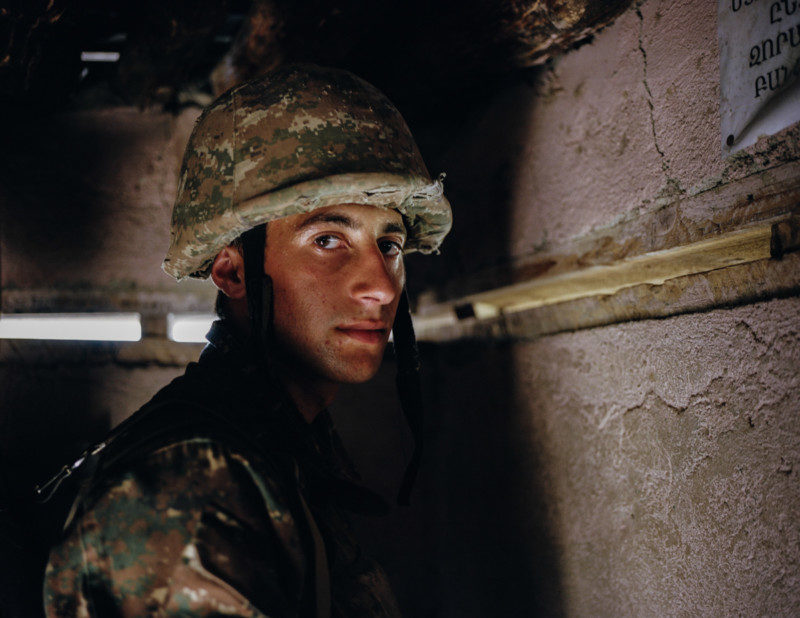Of Armenian and French origin, Alexis Pazoumian is a photographer and director. He was born in Paris France, and later attended a four-ear graphic design school in Paris. The concepts of territory, identity, and society interest him. Through few photographic projects in the favelas of Brazil, India, Armenia and recently in New-Orleans he wants to study human in their environment. Alexis joined the Hans Lucas Studio in 2016.

Mountain view from Tatev – On the road leading to High Karabagh

Stepanakert – Old city airport

Church of the village of Sushi – Woman praying during the Sunday mass
The Nagorno-Karabagh is a mountainous, large region as a French department, which declared independence in 1991 by breaking away from Azerbaijan at the cost of a bloody war between Armenians and Azeris. In 1917 a Russian census revealed that this area was populated
by 94% Armenian. But after the annexation of the region to the USSR, the Soviet government integrated the Karabakh to Azerbaijan in the form of an autonomous region ; anti-Armenian pogroms took place In 1988 in Baku and Sumgait, and local elected upper Karabakh
demanded their unification to Armenia; Refusal of Moscow; this war has claimed more than 30,000 deaths and chased thousands of Armenians from their homes. The Armenians largely prevailed.The signing of a ceasefire in 1994 was not strongly enforced, and has not resolved the conflict between Baku and Yerevan, as they fail to agree on the status of the region. Karabakh is an independent republic which is recognized only by Armenia.
This bloody war was one of the most destructive conflicts in the post USSR. Although the ceasefire is yet in force, deadly fighting broke out regularly along the border. On April 2-3, 2016, an intense fight erupted along the front line between Armenian and Azerbaijani armed forces. These are the most violent clashes since the ceasefire in 1994. The truce was violated by Baku, so the fights are increasingly recurring to either side, causing the many young soldiers to die. We now know the existence of the Armenian genocide perpetrated by the Turks in 1915, but less is known about the existence of the Nagorno-Karabagh.
On my arrival in Yerevan, the capital of Armenia, in June 2016, I saw military trucks which carried young Armenian soldiers. There was great excitement among the young recruits who showed their determination to defend their ancestral territory. We had to calm their enthusiasm and patriotism. My purpose in photography is to collect testimonies that reflect the human situation after the conflict. This is what I have done for a month. This is for me another way of telling the war. After spending a few weeks in the mountains and the front line, I made a report reflecting the human condition. These women, these young soldiers dream only about a thing: PEACE. This frozen conflict recalls the impossible mourning of the unrecognized genocide of 1915.
Heavy silence from the front—Youth on alert.

Soldier back from the front – Everyday during his permission he comes to pray at Sushi’s church

Nariné – A resident from the village of Sushi

Styopa Avanessian, 65 y.o., sports teacher – Former mayor of Madaghis village during the 90-94 war, and also was part of the liberation army. He hasn’t left the village since the conflict in order to bring his help to the villagers. Before the beginning of the attacks, Magadhis had 672 residents, yet only 200 villagers returned. His son, Zaven, is the present mayor. On the night of April 2nd, he went to survey the damage done to the village. During this time, a missile exploded next to his car and he was badly injured. As a result of his injuries, he spent 15 days in the hospital. On April 5th, he sent his family to Erevan. In the village, 34 houses were hit, and there were numerous casualties. Since then he’s been helping to build a hospital in case there is a new attack.

Gasparian Nela – Resident from the village of Madaghis, with her family – She was the village’s mayor in 1994 during the first war. On the night of Apr. 2 at 2 AM, Gasparian and her family were awoken by the sound of bombs. One of the missiles exploded next to their house, and all the windows were shattered. They couldn’t get out for 3 hours because
of the gun fights outside of their home. The family’s father decided to hide his children under his bed because their biggest fear was that the Azeri army would come in and kill the entire family. Later, the village’s chief arrived to take them to a shelter in a nearby village. Since the beginning of the conflict, they all returned to live in the village where they
were born. They don’t want to go and they cannot imagine living in a different place.

Talish Elementary School’s gymnasium – Presently destroyed, it was the first building hit by the bombings. Since then, all the residents from Talish live in hotels in Stepanakert. No one has been able to come back, as there are regularly sniper shots on the villagers who come back to visit their destroyed house.

Eric and Aris – They’re back from the war front to rest at the barracks for a few days before returning to their line of duty.

Tigrane – A soldier resting in the barracks, and is revealing the miniature model of a church he built himself.

Martakert village – Soldiers parading in front of the spectators who came to celebrate the village’s Independence Day.

Stepanakert barracks – Armen is 19 years of age and has been in the army for one year. The soldiers live in the barracks before they are sent to the front lines. They’re all between 18-20 years old. Everyday, they undergo real situation training in order to prepare for battle. They’re also taught first aid so they can rescue their injured comrades.

Stepanakert barracks – The soldiers in a lounge relaxing in front of the TV.

On the road to the front – Soldiers leaving the barracks to get back to the front lines.

Mouchegh, 19 years old – He resides at a look-out post every day in case of an attack from the opposing army. The front is 500m away. After the army, he wishes to go back to university and find a job. His dream is to become a veterinarian.

Chamik, 20 years old – He’s in the trenches, at the monitoring station – The soldiers permanently watch any activity from the Azeri army, only 500m away from them.
To view more of Alexis’ work, please visit his website.